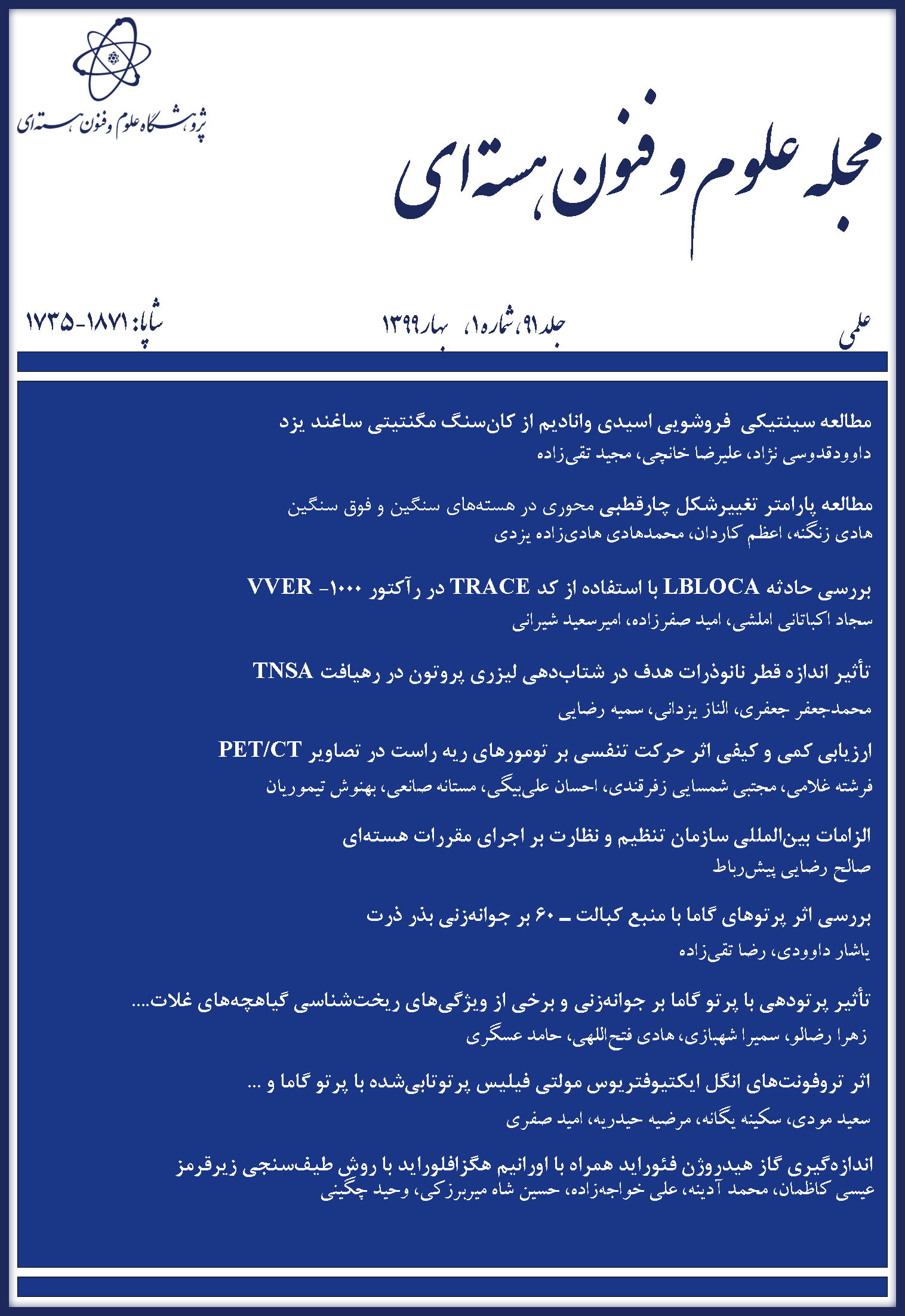نوع مقاله : مقاله پژوهشی
نویسندگان
1 پژوهشکده پلاسما و گداخت هستهای، پژوهشگاه علوم و فنون هستهای، سازمان انرژی اتمی ایران، صندوق پستی: 51113-14399، تهران- ایران
2 گروه فیزیک، دانشکده علوم پایه، دانشگاه تربیت مدرس، صندوق پستی: 175-14115، تهران- ایران
چکیده
مکانیزم شتابدهی غلافی پروتون (TNSA) یکی از رایجترین مکانیزمهای شتابدهی پروتون در چیدمانهای تجربی میباشد. در این پژوهش با استفاده از شبیهسازیهای دو بعدی ذره در سلول (PIC) به مطالعه اثر یونیزاسیون میدانی در برهمکنش پالس لیزر شدت بالا با طول پالسهای مختلف بر روی عملکرد شتابدهی پروتون پرداخته شده است. برای این منظور دو هدف جامد (تقریباً خنثی) و نیز پلاسمای کاملاً یونیزه از جنس آلومینیم با ضخامت 5/0 میکرومتر که با یک لایه نازک هیدروژن با ضخامت 50 نانومتر جفت شده است در نظر گرفته شدهاند. نتایج شبیهسازی نشان میدهد با ثابت گرفتن انرژی پالس لیزر و برای شدتهای متوسط لیزری (در اینجا a0=10 برای پالس با پهنای 25 فمتوثانیه) استفاده از ساختار جامد منجر به افزایش انرژی بیشینه پروتونها حدود 36 درصد نسبت به حالت هدف با ساختار پلاسما میشود. به علاوه اختلاف ایجاد شده در انرژی قطع در دو حالت هدف جامد و پلاسمای ایدهآل با افزایش پهنای پالس لیزری کاهش مییابد.
کلیدواژهها
عنوان مقاله [English]
Field ionization effect on the proton acceleration scheme via high intensity laser interaction with target at different pulse durations
نویسندگان [English]
- S. Rezaei 1
- M.J. Jafari 1
- E. Yazdani 2
1 Plasma and Nuclear Fusion Research School, Nuclear Science and Technology Research Institute, AEOI, P.O.BOX: 14399-51113, Tehran - Iran
2 Department of Physics, Faculty of Basic Sciences, Tarbiat Modares University, P.O. Box: 14115-175, Tehran-Iran
چکیده [English]
Target Normal Sheath Acceleration (TNSA) mechanism is one of the most common proton acceleration mechanisms in the experimental setup. In this work, the effect of field ionization on the proton acceleration performance in result of the interaction of high intensity laser pulses with different pulse lengths was studied using two-dimensional particle in cell (PIC) simulations. For this purpose, two solid (neutral) targets as well as fully ionized plasma target, made of aluminum layer with thickness of 0.5 μm, and paired with a thin layer of hydrogen with thickness of 50 nm are considered. Simulation results showed that considering the constant pulse energy and a medium laser intensity (here a0 =10 for pulse width of 25 femtoseconds) the use of solid structure leads to an increase in the maximum energy of the protons by about 36%. In addition, the difference in proton cut-off energy between the solid target and the ideal plasma one decreases with increasing the laser pulse width.
کلیدواژهها [English]
- Particle in cell simulation
- Laser proton acceleration
- TNSA mechanism
- Laser pulse duration
- Field ionization
- M. Roth, et al, Fast ignition by intense laser-accelerated proton beams, Physical Review Letters, 86(3), 436 (2001).
- D. Higginson, et al., Production of neutrons up to
18MeV in high-intensity, short-pulse laser matter interactions, Physics of Plasmas, 18(10),100703 (2011).
- S. Bulanov, et al, Oncological hadrontherapy with laser ion accelerators, Physics Letters A., 299(2-3), 240-7 (2002).
- S. Wilks, et al., Energetic proton generation in ultra-intense laser–solid interactions, Physics of Plasmas, 8(2), 542-9 (2001).
- T. Esirkepov, et al, Highly efficient relativistic-ion generation in the laser-piston regime, Physical Review Letters, 92(17), 175003 (2004).
- L.O. Silva, et al., Proton shock acceleration in laser-plasma interactions, Physical Review Letters, 92(1), 015002 (2004).
- O. Jäckel, et al, All-optical measurement of the hot electron sheath driving laser ion acceleration from thin foils, New Journal of Physics, 12(10), 103027 (2010).
- D. Neely, et al, Enhanced proton beams from ultrathin targets driven by high contrast laser pulses, Applied Physics Letters, 89(2), 021502 (2006).
- D. Margarone, et al., Laser-driven proton acceleration enhancement by nanostructured foils, Physical Review Letters, 109(23), 234801 (2012).
- F. Dollar, et al., High contrast ion acceleration at intensities exceeding 10 21 W cm−2, Physics of Plasmas, 20(5), 056703 (2013).
- T. Bartal, et al, Focusing of short-pulse high-intensity laser-accelerated proton beams, Nature Physics, 8(2), 139 (2012).
- A. Sgattoni, et a, Laser ion acceleration using a solid target coupled with a low-density layer, Physical Review E., 85(3), 036405 (2012).
- E. Khalilzadeh, et al, The effect of the laser pulse shape on the wakefield generation in field-ionized plasma, Chinese Journal of Physics, 71, 212-23 (2021).
- A.J. Kemp, R.E. Pfund, J. Meyer-ter-Vehn, Modeling ultrafast laser-driven ionization dynamics with Monte Carlo collisional particle-in-cell simulations, Physics of Plasmas, 11(12), 5648-57 (2004).
- L. Keldysh, Ionization in the field of a strong electromagnetic wave, Sov Phys JETP, 20(5), 1307-14 (1965).
- H.R. Reiss, Effect of an intense electromagnetic field on a weakly bound system, Physical Review A., 22(5), 1786 (1980).
- M.V. Ammosov, Tunnel ionization of complex atoms and of atomic ions in an altemating electromagnetic field, Sov Phys JETP, 64, 1191 (1987).
- J. Derouillat, et al, Smilei: A collaborative, open-source, multi-purpose particle-in-cell code for plasma simulation, Computer Physics Communications, 222, 351-73 (2018).

